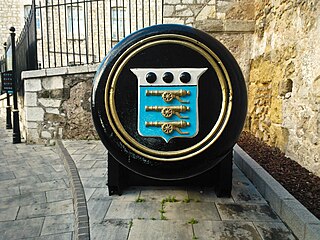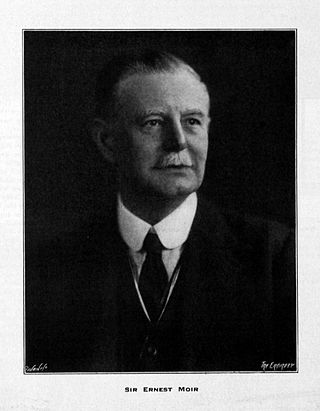Related Research Articles

Cordite is a family of smokeless propellants developed and produced in Britain since 1889 to replace black powder as a military firearm propellant. Like modern gunpowder, cordite is classified as a low explosive because of its slow burning rates and consequently low brisance. These produce a subsonic deflagration wave rather than the supersonic detonation wave produced by brisants, or high explosives. The hot gases produced by burning gunpowder or cordite generate sufficient pressure to propel a bullet or shell to its target, but not so quickly as to routinely destroy the barrel of the gun.

A cluster munition is a form of air-dropped or ground-launched explosive weapon that releases or ejects smaller submunitions. Commonly, this is a cluster bomb that ejects explosive bomblets that are designed to kill personnel and destroy vehicles. Other cluster munitions are designed to destroy runways or electric power transmission lines.

Aberdeen Proving Ground (APG) is a U.S. Army facility located adjacent to Aberdeen, Harford County, Maryland, United States. More than 7,500 civilians and 5,000 military personnel work at APG. There are 11 major commands among the tenant units, including:

Bomb disposal is an explosives engineering profession using the process by which hazardous explosive devices are disabled or otherwise rendered safe. Bomb disposal is an all-encompassing term to describe the separate, but interrelated functions in the military fields of explosive ordnance disposal (EOD) and improvised explosive device disposal (IEDD), and the public safety roles of public safety bomb disposal (PSBD) and the bomb squad.

The Board of Ordnance was a British government body. Established in the Tudor period, it had its headquarters in the Tower of London. Its primary responsibilities were 'to act as custodian of the lands, depots and forts required for the defence of the realm and its overseas possessions, and as the supplier of munitions and equipment to both the Army and the Navy'. The Board also maintained and directed the Artillery and Engineer corps, which it founded in the 18th century. By the 19th century, the Board of Ordnance was second in size only to HM Treasury among government departments. The Board lasted until 1855, at which point it was disbanded.

The Royal Arsenal, Woolwich is an establishment on the south bank of the River Thames in Woolwich in south-east London, England, that was used for the manufacture of armaments and ammunition, proofing, and explosives research for the British armed forces. It was originally known as the Woolwich Warren, having begun on land previously used as a domestic warren in the grounds of a mid-16th century Tudor house, Tower Place. Much of the initial history of the site is linked with that of the Office of Ordnance, which purchased the Warren in the late 17th century in order to expand an earlier base at Gun Wharf in Woolwich Dockyard.
Sir Henry Thomas Tizard was an English chemist, inventor and Rector of Imperial College, who developed the modern "octane rating" used to classify petrol, helped develop radar in World War II, and led the first serious studies of UFOs.

The Shell Crisis of 1915 was a shortage of artillery shells on the front lines in the First World War that led to a political crisis in the United Kingdom. Previous military experience led to an over-reliance on shrapnel to attack infantry in the open, which was negated by the resort to trench warfare, for which high-explosive shell were better suited. At the start of the war there was a revolution in doctrine: instead of the idea that artillery was a useful support for infantry attacks, the new doctrine held that heavy guns alone would control the battlefield. Because of the stable lines on the Western Front, it was easy to build railway lines that delivered all the shells the factories could produce. The 'shell scandal' emerged in 1915 because the high rate of fire over a long period was not anticipated and the stock of shells became depleted. The inciting incident was the disastrous Battle of Aubers, which reportedly had been stymied by a lack of shells.

A dual-purpose improved conventional munition (DPICM) is an artillery or surface-to-surface missile warhead designed to burst into submunitions at an optimum altitude and distance from the desired target for dense area coverage. The submunitions use both shaped charges for the anti-armor role, and fragmentation for the antipersonnel role, hence the nomenclature "dual-purpose". Some submunitions may be designed for delayed reaction or mobility denial (mines). The air-to-surface variety of this kind of munition is better known as a cluster bomb. They are banned by more than 100 countries under the Convention on Cluster Munitions.

The Royal Army Ordnance Corps (RAOC) was a corps of the British Army. At its renaming as a Royal Corps in 1918 it was both a supply and repair corps. In the supply area it had responsibility for weapons, armoured vehicles and other military equipment, ammunition and clothing and certain minor functions such as laundry, mobile baths and photography. The RAOC was also responsible for a major element of the repair of Army equipment. In 1942 the latter function was transferred to the Royal Electrical and Mechanical Engineers (REME) and the vehicle storage and spares responsibilities of the Royal Army Service Corps were in turn passed over to the RAOC. The RAOC retained repair responsibilities for ammunition, clothing and certain ranges of general stores. In 1964 the McLeod Reorganisation of Army Logistics resulted in the RAOC absorbing petroleum, rations and accommodation stores functions from the Royal Army Service Corps as well as the Army Fire Service, barrack services, sponsorship of NAAFI (EFI) and the management of staff clerks from the same Corps. On 5 April 1993, the RAOC was one of the corps that amalgamated to form The Royal Logistic Corps (RLC).

The United States Army Ordnance Corps, formerly the United States Army Ordnance Department, is a sustainment branch of the United States Army, headquartered at Fort Gregg-Adams, Virginia. The broad mission of the Ordnance Corps is to supply Army combat units with weapons and ammunition, including at times, their procurements and maintenance. Along with the Quartermaster Corps and Transportation Corps, it forms a critical component of the U.S. Army logistics system.

The Imperial Munitions Board (IMB) was the Canadian branch of the British Ministry of Munitions, set up in Canada under the chairmanship of Joseph Wesley Flavelle. It was formed by the British War Cabinet to alleviate the Shell Crisis of 1915 during the First World War. The Board was mandated to arrange for the manufacture of war materials in Canada on behalf of the British government.

The Naval Consulting Board, also known as the Naval Advisory Board, was a US Navy organization established in 1915 by Josephus Daniels, the Secretary of the Navy at the suggestion of Thomas Alva Edison. Daniels created the Board with membership drawn from eleven engineering and scientific organizations two years before the United States entered World War I to provide the country with the "machinery and facilities for utilizing the natural inventive genius of Americans to meet the new conditions of warfare." Daniels was concerned that the U.S. was unprepared for the new conditions of warfare and that they needed access to the newest technology.

A precision-guided munition (PGM), also called a smart weapon, smart munition, or smart bomb, is a type of weapon system that integrates advanced guidance and control systems, such as GPS, laser guidance, or infrared sensors, with various types of munitions, typically missiles or artillery shells, to allow for high-accuracy strikes against designated targets. PGMs are designed to precisely hit a predetermined target, typically with a margin of error that is far smaller than conventional unguided munitions. Unlike unguided munitions, PGMs use active or passive control mechanisms capable of steering the weapon towards its intended target. PGMs are capable of mid-flight course corrections, allowing them to adjust and hit the intended target even if conditions change. PGMs can be deployed from various platforms, including aircraft, naval ships, ground vehicles, ground-based launchers, and UAVs. PGMs are primarily used in military operations to achieve greater accuracy, particularly in complex or sensitive environments, to reduce the risk to operators, lessen civilian harm, and minimize collateral damage. PGMs are considered an element of modern warfare to reduce unintended damage and civilian casualties. It is widely accepted that PGMs significantly outperform unguided weapons, particularly against fortified or mobile targets.
The Advisory Committee for Aeronautics (ACA) was a UK agency founded on 30 April 1909, to undertake, promote, and institutionalize aeronautical research. In 1919 it was renamed the Aeronautical Research Committee, later becoming the Aeronautical Research Council.

The Board of Invention and Research (BIR) was a British expert-level committee, initiated by the Admiralty of the Royal Navy. Established in 1915, the board was responsible for soliciting expert scientific assistance to solve tactical and technical problems. It was a sister organisation to the Munitions Inventions Department which had been set up in April 1915 and the Air Inventions Committee (AIC), once it became become fully operational in the summer of 1917.

Sir Ernest William Moir was a British civil engineer and the first Moir baronet. He is credited with inventing the first medical airlock while working on the Hudson River Tunnel in New York in 1889.
This is a list of MBEs awarded in the 1919 New Years Honours.
The Anti-Aircraft Experimental Section of the Munitions Inventions Department was an organisation set up within Lloyd George's Ministry of Munitions in early 1916. Originally based at Northholt aerodrome, in May 1916 the section moved to the National Physical Laboratory at Bushy House, Teddington before moving to HMS Excellent on Whale Island near Portsmouth in Hampshire in September 1916. The section was led by the physiologist A. V. Hill, who was previously a Captain in the Cambridgeshire Regiment. While on leave suffering from flu in January 1916, Horace Darwin approached him to work on anti-aircraft measures. Hill accepted and started to find the personnel for the unit, which acquired the nickname "Hill's Brigands".

Sir Henry Edward Fane Goold-Adams KBE CB CMG was an officer in the British Army who gained the rank of Colonel in the Royal Artillery.
References
- 1 2 3 4 5 6 7 8 Pattison, Michael (1983). "Scientists, Inventors and the Military in Britain, 1915-19: The Munitions Inventions Department" . Social Studies of Science. 13 (4): 521–568. doi:10.1177/030631283013004004. ISSN 0306-3127. JSTOR 284847. S2CID 145727609.
- ↑ Williams, Philip Hamlyn (2018). Ordnance: Equipping the British Army for the Great War. Stroud: History Press. ISBN 978-0-7509-8872-8.
- ↑ Mills, Steve (2019). The Dawn of the Drone: from the back room boys of the Royal Flying Corps. Havertown: Casemate. p. 225. ISBN 9781612007908.